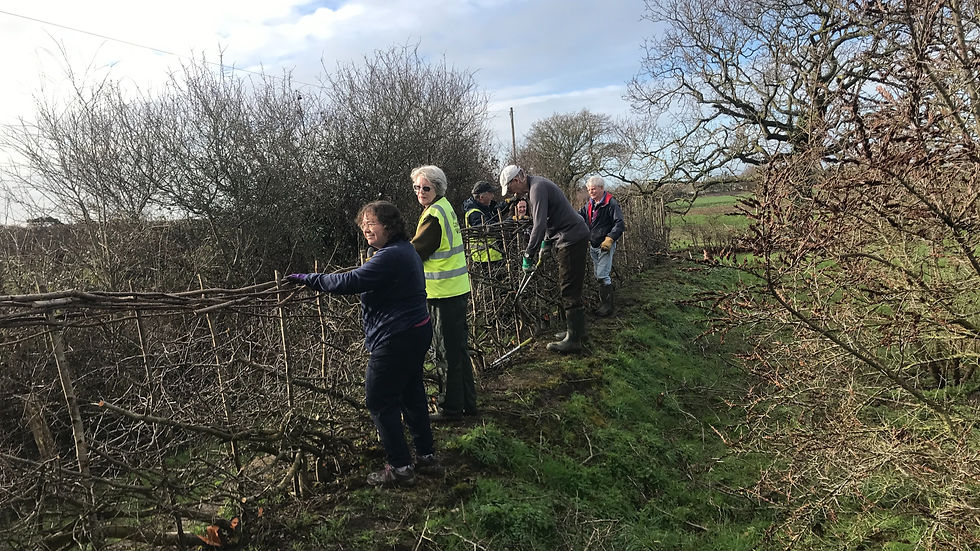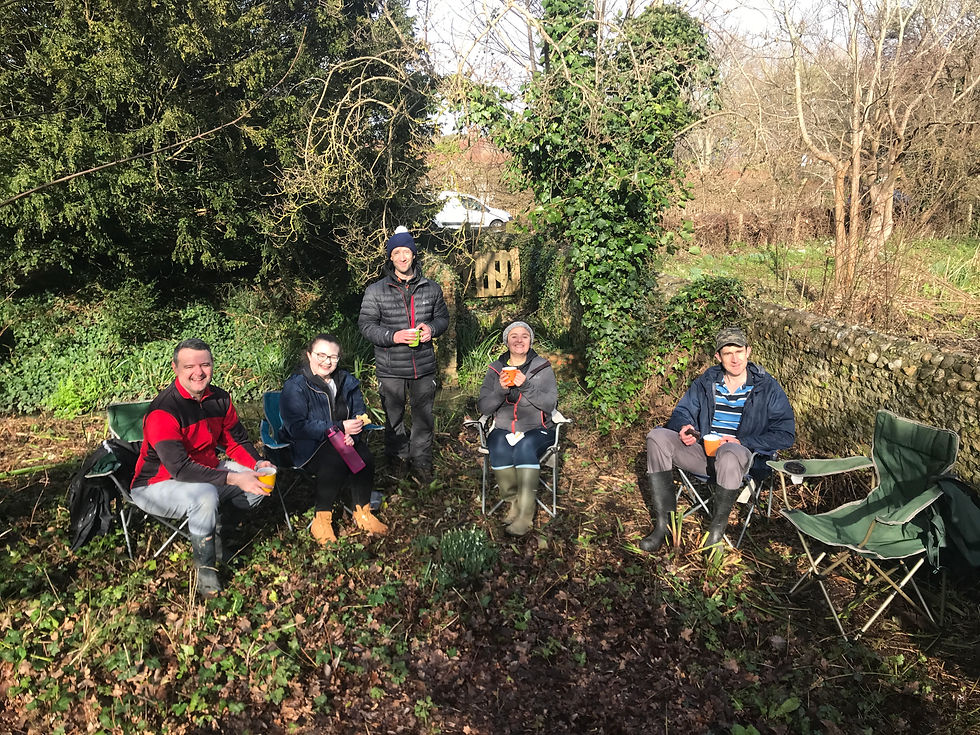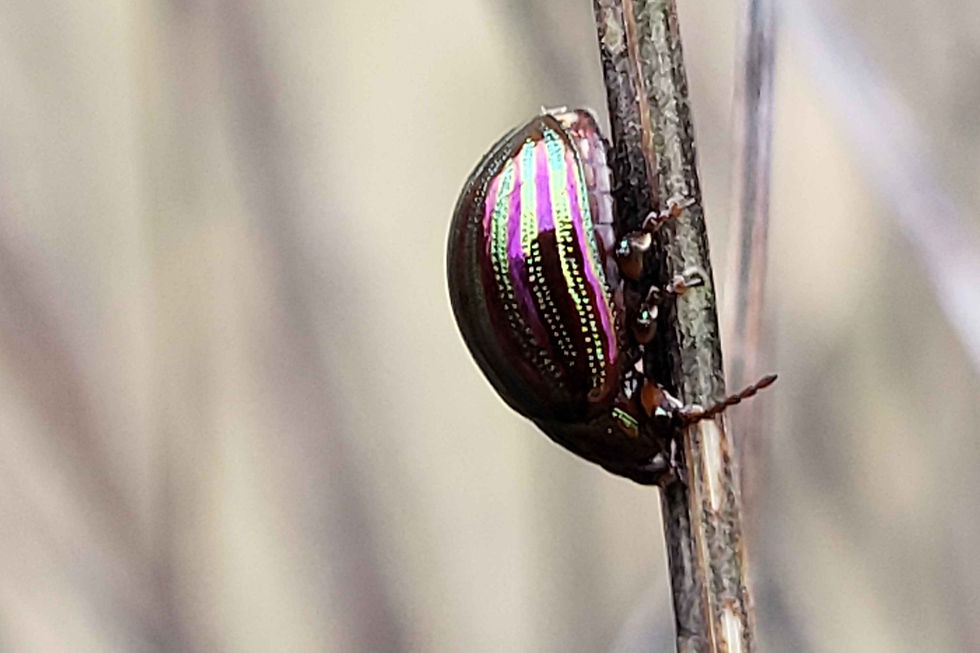MWHG Newsletter: 11th March 2024
- MWHG Team
- Mar 11, 2024
- 8 min read
Updated: Feb 26
Dear Volunteers and Supporters,
In the March edition of our newsletter we talk about a recent visit from the High Sheriff of West Sussex, introduce a new addition to the Wittering Area Community Conservation Project team, and share more heritage and nature updates from our busy projects.
High Sheriff Visit
By Jane Scotland

The High Sheriff of West Sussex, Andy Bliss, braved the mud and rain to visit our projects this month. Andy met us in September at the BBC Make a Difference awards and was keen to find out more about MWHG.
We started in the Selsey Town Hall where Andy met the Leader of Selsey Town Council, Andrew Brown and Town Clerk, Robin Davison along MWHG Chair Lesley Bromley, Trustee Mike Beal and Paul Bedford.
We then headed out to show Andy a tree and hedge planting project in Highleigh. Emma Horton, MWHG Project Leader explained the challenges of planting 800m of hedge in the middle of an extremely wet winter.

Next stop was Triangle Pond in Birdham to show the diversity of wildlife that can be found in a small area of managed wetland and woodland.

The final stop was the site of the Sidlesham Tramway stop on the edge of Pagham Harbour.

After the visit, Andy Bliss emailed "I am writing to thank you and everyone I met on Friday for a brilliant visit to the Manhood Peninsula on Friday. I knew I was in for a treat; I had been looking forward to the visit and wasn’t disappointed! Please will you pass on my thanks to everyone involved.
I very much enjoyed my visit and learned a great deal. The landscape is beautiful and rich in natural and cultural heritage and collectively your various projects do much to conserve and protect it."
Heritage update
By Bill Martin | Sidlesham Heritage Project, Selsey Tramway Project

The Heritage map on the website is being updated with a list of heritage assets for all the parishes on the Manhood Peninsula.
MWHG will be hosting an exhibition at The Novium on the Selsey Tramway from July 2024 until March 2026 a film to accompany the exhibition is currently being made.
The renovation of Chalder Station is ongoing.
The LSA house which was dismantled in 2017 is now part of the Weald and Downland Museum's development plan and a site has been identified.
Wittering Area Community Conservation Project Update
By Jane Reeve | Wittering Area Community Conservation Project

We waved a sad goodbye to Louise in January as she started a new and exciting opportunity working for a parish council on their estates team. Emma, a long-term volunteer, has joined Jane to help support the Community Conservation work and to be an all-important additional set of hands for children’s activities and engagement. Emma has been a Primary School teacher and a Teaching Assistant so brings much to the role with energy and enthusiasm, creativity, and an understanding of young children’s interests.

We have had a busy start to the year with our weekly habitat management sessions with our brilliant volunteers – as we make the most of our opportunity to remove invasive vegetation this time of year, opening up banks of streams, ditches, and ponds, and getting light onto the ground. This invariably involves bramble bashing, an often-painful pursuit but ultimately rewarding! We have worked on a variety of sites from Hilton Park pond in east Wittering, originally a rubbish dump but now a large and beautiful pond, to the bus stop area at West Wittering which we have tried to gently rewild with less mowing and some wildflower seed sowing.

We were very fortunate in mid-February to be joined by a team of WSCC employees from their sustainability team. They mainly work out of the Chichester office so were pretty local and keen to do something outdoors. They joined us as they had seen the MWHG website and the Corporate Volunteer Days offer. This has proved very popular and we receive many requests from a range of companies about join us and helping out which is great. It allows them to learn more about the environment, come together as a team and to achieve a goal, and helps us to make a real difference on some of our bigger sites when it comes to cutting back bramble and willow. The WSCC team and a brilliant day out, it just about stayed dry, and they were really pleased with what they had achieved. As Rosie, one of the team said, “we are involved in projects that take years to deliver so to come and get an instant sense of satisfaction and to see what has been achieved felt so good”.
We aim to give corporate teams autumn, winter, and spring work so that they can be outdoors doing something physical and summer work can be hot and requires some training of pre knowledge for species surveying. We have had requests for sessions that can host coach loads of volunteers – 28 and 35 people but are often limited by car parking availability and toilet facilities. We try and accommodate when we can but it can be a juggle. Big thanks to a carpentry company and a gym in East Wittering who have allowed us to use their toilet facilities when hosting corporate volunteers, this really is the epitome of community support.

One of the sites that we work on is called Hedgehog Hall pond in Earnley and while working on this attracted wetland feature two volunteers repeatedly saw a kingfisher fly up and down. That is the joy of these sites, we never know what we are going to see but it is a real treat and a privilege when something does show itself.
We had a great couple of sessions laying a young hawthorn hedge is Earnley and by the end it looked very impressive, It is good to learn these traditional hedgelaying techniques and countryside traditions and should make for a strong and thick hedge in a year or two. We all came away with a sense of satisfaction at how much we had achieved and the laid hedge really did look impressive.
We finished running the Wildlife Warriors club with East Wittering Primary school in February and as ever had a very enthusiastic team of youngsters with lots of questions and energy. When carrying out the owl pellet dissection activity they transitioned from a ‘yuck that’s disgusting’ to wanting more pellets and competing over who had found the largest vole / mouse skull. It is so important to engage young children in nature as they get less opportunities to go outside and to explore and discover things for themselves.
The spring months will bring different volunteering opportunities with wildflower seeding, invasive species removal and some large engagement events where we are going to need lots of help.
Recent Project Updates
By Joe Savill | Vitacress Survey Project, Selsey Photo Archive Project

Vitacress Survey Project
This year’s survey plan has been agreed and we intend to start the surveys in April. Birds, butterflies and pollinators will be the focus of the surveys this year. We also hope to hold one or two moth trapping sessions.
We are still looking for new volunteers as this will help us to ensure regular surveys throughout the year. Only basic ID knowledge is needed and help will always be on hand from the rest of the team. It’s a lovely, peaceful site to walk around, mostly flat, and full of wildlife so do join us.
Contact Joe via jsavill@mwhg.org.uk

Selsey Photo Archive Project
We are continuing with the normal work: scanning and cataloguing new collections; publishing new photos on the website and responding to research requests, received via the Selsey Photo Archive website.
We’ve been working on a website map to show the location of some of the photos and this will be ready to go live soon.
We are continuing to interview older Selsey residents to record their memories. We intend to use parts of these interviews on the website and in future displays. It’s been fascinating so far.
Southern Water Hedging Our Future Project
By Jane Reeve | Hedging Our Future Project

We are coming towards the end of our tree planting window as the best time to plant trees is between November and the end of February. From March young trees start to put out small white micro roots and begin to leaf up and really need to be in a growing medium to start absorbing the nutrients they need to flourish.
We have had an amazing planning season and have managed to plant 2500 trees in 14 sessions totalling 720 metres of new hedge. When looking at the position of this new hedge, the gaps it fills and the joining up of existing hedges, we have actually made improvements across approximately 1500 metres of hedgerow. The enthusiasm and energy of our volunteers has been amazing and we have been fortunate to have a committed group of 6 hardcore volunteers that have joined us most weeks and then others that have come along when they can. The weather hasn’t been kind so it really has been staggering how much we have done.
We were successful in our application for more funds to buy trees and guards from the Tree Council’s Branching Out Grant so we bought more native species trees that have been used for this year planting.
As this Southern Water grant finishes at the end of March we are hugely grateful to Jen Pollitt, Southern Water’s Nature-based Solutions Senior Officer, Catchment Delivery Team who had overseen the work as well as others on the Steering Group who helped to guide the work, come up with helpful suggestions and ideas and these included: Tom Monnington (Sidlesham farmer), Pete Hughes (Chichester Harbour Conservancy), Sarah Hughes (CDC Strategic Wildlife Corridor Project Officer), Dr Alison Barker (Consultant Entomologist), Dr Jill Sutcliffe (MWHG management team), David Gilby (MWHG Trustee) and Paul Bedford (MWHG management team).
We will spend a March or April volunteer session putting our remaining trees back into the Selsey Tree nursery and the West Wittering Tree nursery so that they can looked after over the summer and be ready for planting in the new year. They will be joined by the seedlings that have germinated from seeds collected in Autumn 2023 and which have been looked after and hopefully will be ready for planting out in June. We will also be putting down a layer of mulch on our planted trees to help retain moisture, supress bramble growth and to give these trees the best chance of long-term survival.
The great news is that the MWHG have been awarded another 1-year Conservation Grant by Southern Water and this time our aim is to plant trees across Hunston and North Mundham Parishes. So, our home-grown trees will get planted locally and to make a difference to the landscape and the wildlife corridors, along with the other multiple benefits, to the area north of Pagham Harbour.
A New Way to Submit Your Wildlife Records
By Nikki Timney | Find Wildlife From Home Survey

In February, we launched a new survey form which allows you to submit your wildlife records online. This survey is hosted by Microsoft Forms and can be completed on a desktop, or a mobile device for recording on the go!
Visit our Find Wildlife From Home survey page to learn more about how to submit your records, or go straight to the survey to tell us about the wildlife you've seen.
Survey Results for January and February 2024

We've had a great start to the year, receiving a total of 108 records in January and February. These records consisted of 33 different species and 613 individuals! To date, our wildlife survey has received 1,350 records. Read a selection of the January to February survey submissions, below.
2 Common Frogs | 1 Smooth Newt | 25 Rosemary Beetles |
1 Red Fox | 33 Blackbirds | 13 Blue Tits |
4 Canada Geese | 142 Starlings | 3 Chaffinches |
16 Long-tailed Tits | 50 Curlews | 73 Coots |
5 Tufted Ducks | 2 Green Woodpeckers | 1 Little Egret |
Tell us about the wildlife you've seen in your garden, neighbourhood and surrounding local area and we will also submit your records to the National Biological Records Centre on your behalf.
To take part in our wildlife survey, click on the button below.





Comments